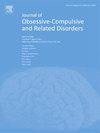耶鲁-布朗强迫症量表(第二版)自我报告的心理测量特征
IF 1.5
4区 医学
Q3 PSYCHIATRY
Journal of Obsessive-Compulsive and Related Disorders
Pub Date : 2025-01-01
DOI:10.1016/j.jocrd.2024.100932
引用次数: 0
摘要
耶鲁-布朗强迫症量表(Y-BOCS)是衡量强迫症状严重程度的黄金标准工具。引入了更新的第二版,以解决原始仪器的局限性,包括临床管理和自我报告版本。没有发表的研究检验了自我报告版本的心理测量特性,这是当前研究的目的。被诊断为强迫症(OCD, N = 67)的个体完成了由医生管理和自我报告的Y-BOCS-II,以及许多其他自我报告测量,以平衡的顺序评估强迫症症状、抑郁和症状损害。结果表明,一个内部一致的测量方法(α = 0.90)与包括临床评定的Y-BOCS-II在内的强迫症症状测量方法具有很强的收敛效度,但与强迫症量表修订版只有适度的相关性。自我报告版本也表现出公平的区别效度。该测量的可靠变化指数为8,这与强迫症认知行为治疗后的大效应大小有关。局限性包括以白人和女性为主的样本。Y-BOCS-II的自我报告版本似乎是一种心理计量学上合理的测量方法,用于强迫症患者,尽管它区分强迫症与其他以焦虑或抑郁为特征的疾病的能力需要进一步研究。本文章由计算机程序翻译,如有差异,请以英文原文为准。
Psychometric properties of the Yale-Brown obsessive-compulsive scale, second edition, self-report (Y-BOCS-II-SR)
The Yale-Brown Obsessive-Compulsive Scale (Y-BOCS) is the gold-standard tool for measuring obsessive compulsive symptom severity. An updated second edition was introduced to address limitations of the original instrument, with both clinician-administered and self-report versions. No published studies have examined the psychometric properties of the self-report version, which is the purpose of the current study. Individuals with a diagnosis of obsessive-compulsive disorder (OCD, N = 67) completed the clinician-administered and self-report Y-BOCS-II, as well as a number of other self-report measures assessing obsessive-compulsive symptoms, depression, and impairment from symptoms in a counterbalanced order. Results suggest an internally consistent measure (α = .90) that has strong convergent validity with measures of OCD symptoms including the clinician-rated Y-BOCS-II, but only moderate correlations with the Obsessive-Compulsive Inventory-Revised. The self-report version also demonstrated fair discriminant validity. A reliable change index of 8 was found for this measure, which was associated with a large effect size following cognitive-behavioral therapy for OCD. Limitations include a predominantly White and female sample. The self-report version of the Y-BOCS-II appears to be a psychometrically reasonable measure for use with individuals with OCD though its ability to discriminate OCD from other disorders characterized by anxiety or depression requires further study.
求助全文
通过发布文献求助,成功后即可免费获取论文全文。
去求助
来源期刊
CiteScore
4.00
自引率
5.60%
发文量
46
审稿时长
47 days
期刊介绍:
Journal of Obsessive-Compulsive and Related Disorders (JOCRD) is an international journal that publishes high quality research and clinically-oriented articles dealing with all aspects of obsessive-compulsive disorder (OCD) and related conditions (OC spectrum disorders; e.g., trichotillomania, hoarding, body dysmorphic disorder). The journal invites studies of clinical and non-clinical (i.e., student) samples of all age groups from the fields of psychiatry, psychology, neuroscience, and other medical and health sciences. The journal''s broad focus encompasses classification, assessment, psychological and psychiatric treatment, prevention, psychopathology, neurobiology and genetics. Clinical reports (descriptions of innovative treatment methods) and book reviews on all aspects of OCD-related disorders will be considered, as will theoretical and review articles that make valuable contributions.
Suitable topics for manuscripts include:
-The boundaries of OCD and relationships with OC spectrum disorders
-Validation of assessments of obsessive-compulsive and related phenomena
-OCD symptoms in diverse social and cultural contexts
-Studies of neurobiological and genetic factors in OCD and related conditions
-Experimental and descriptive psychopathology and epidemiological studies
-Studies on relationships among cognitive and behavioral variables in OCD and related disorders
-Interpersonal aspects of OCD and related disorders
-Evaluation of psychological and psychiatric treatment and prevention programs, and predictors of outcome.

 求助内容:
求助内容: 应助结果提醒方式:
应助结果提醒方式:


